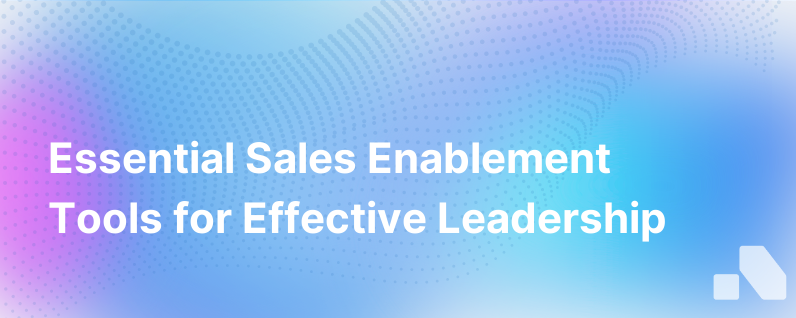
In the hyper-competitive world of B2B sales, organizations need every advantage to outperform competitors and consistently exceed revenue targets. In this environment, sales enablement tools have evolved from a 'nice-to-have' to an indispensable resource. The effective use of sales enablement technology accelerates sales cycles, improves seller performance, and maximizes conversion rates.
With a myriad of tools available, choosing the right ones that fit your sales strategy and business needs can be overwhelming. In this guide, we'll explore what sales enablement tools are, their benefits, key tool categories, and how to select the right solution for your sales organization.
What are Sales Enablement Tools?
Sales enablement tools are applications and platforms designed to provide your sales team with the resources they need to sell more effectively. Resources can include content, training, data, analytics, and more. The goal is to streamline the sales process, reduce administrative burdens, and equip reps with strategic insights they need to nurture and convert leads.
Benefits of Sales Enablement Tools
Sales enablement tools offer numerous advantages:
Increased Productivity: By reducing mundane tasks such as data entry and navigating complex spreadsheets, sales enablement tools free reps to focus on what they do best - selling.
Improved Training and Onboarding: Features like video coaching, interactive learning modules, and real-time feedback accelerate the onboarding process and provide ongoing performance improvement.
Consistent Messaging: Maintaining a repository of approved sales content, like product sheets, proposal templates, and case studies, ensures your reps communicate consistent and on-brand messaging to prospects and customers.
Informed Selling: Access to detailed customer information, competitive intelligence, and market insights help reps personalize their sales messaging and approach.
Enhanced Collaboration: Sales enablement platforms facilitate better collaboration between sales, marketing, and customer success teams, fostering a unified customer journey.
Advanced Analytics: With built-in analytics, you can measure the success of your sales efforts, identify areas for improvement, and predict future trends based on historical data.
Top Sales Enablement Tools Categories
Given the broad scope of sales enablement, there is a wide range of tools to consider. Some of the key categories include:
Sales Content Management Tools: These help you create, organize, and track the usage of your sales content. It ensures your sales team has easy access to the most effective content at every stage of the buying journey.
Sales Intelligence Platforms: These tools gather actionable intelligence about prospects, customers, and markets enabling your sales team to identify opportunities, understand buyer needs, and customize their sales approach. Tools like Aomni's AI sales platform take this a step further by delivering real-time account data and personalized sales content.
Customer Relationship Management (CRM) Systems: These are comprehensive platforms that track and manage your interactions with potential and existing customers. They provide a centralized location for customer data, track every interaction, and provide analytics that drive strategic decisions.
Training and Coaching Solutions: These tools help you deliver online training materials to your sales team, monitor their progress, and provide feedback. It's a scalable way to improve your sales team's skills and ensure they're always up to date.
Sales Analytics Platforms: These platforms mine your sales data, generate reports, and offer predictive and prescriptive analytics. Analytics drive decision-making and help you continually refine your sales strategy.
How to Select Sales Enablement Tools?
Given the countless sales enablement tools available, selecting the right ones can be challenging. The following steps can guide the selection process:
- Identify Your Sales Needs: Detail your business objectives and primary sales challenges. These could vary from lead generation, prospect engagement, deal closure, to rep training.
- Define Desired Functions: Based on identified challenges, identify the functions your sales enablement tools should perform. For example, if your challenge is lead engagement, tools with personalization features would be beneficial.
- Check Integration Capabilities: Ensure the tools can integrate with existing systems like CRM or email marketing software for seamless operations and unified reporting.
- Evaluate User-Friendliness: The best tools are intuitive to use and require minimal training to reduce onboarding time and increase adoption rates.
- Set a Budget: Consider direct costs (purchase price, licenses) and indirect costs (implementation, training, maintenance). Align the pricing model to your budget.
- Ask for a Demo: Before finalizing a tool, request a demo. It is the best way to ensure functionality and usability align with your expectations.
Conclusion
Sales enablement tools are revolutionizing the way businesses approach their sales function. By equipping your sales team with sophisticated resources and data-powered insights, you set them up to win in a competitive landscape. Remember, choosing the right tool is about understanding your unique sales process, recognizing the areas that need bolstering, and finding a solution that seamlessly integrates into current workflows. With this guide in hand, you are one step closer to bolstering your sales efforts with the power of enablement technology.
Aomni's AI-driven platform exemplifies how sales enablement tools are evolving. By delivering real-time account research, competitive insights, and personalized sales content, Aomni lets organizations sell more strategically, rapidly increasing efficiency, and revenue.